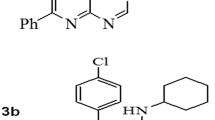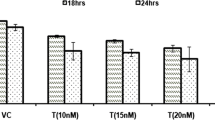Abstract
The trace elements copper, zinc, and selenium are important immune modulators and essential cofactors of the antioxidant enzymes. In the present study, the proliferative effect of human peripheral mononuclear cells (PBMCs) that have been exposed to copper, zinc, and selenium and the corresponding activities of antioxidant enzymes, namely superoxide dismutase (SOD), glutathione peroxidase (GPx), and catalase, were determined. Zinc and copper stimulated the PBMC proliferation in a dose-dependent manner within the dose range 25–200 μmol/L. SOD and GPx activities in PBMCs exposed to zinc were inhibited, whereas catalase activity was unaffected. All the three antioxidant enzymes in the cells exposed to copper were inhibited. Selenium exerted more potent inhibition of the cell proliferation while causing stimulation of the antioxidant enzymes at the lowest dose (25 μmol/L) than at the highest dose (200 μmol/L) tested. A significant negative correlation was observed between proliferation and antioxidant enzyme (SOD and GPx) activities in trace-element-exposed PBMC. The present findings substantiate the importance of trace elements as immune modulators and the involvement of enzymatic antioxidant system in the immune cell regulation.
Similar content being viewed by others
References
C. Hotz, N. M. Lowe, M. Araya, and K. H. Brown, Assessment of the trace element status of individuals and populations: the example of zinc and copper, J. Nutr. 133(5), 1563–1568 (2003).
G. Forte, B. Bocca, O. Senofonte, F. Petrucci, L. Brusa, and P. Stanzione, Trace and major elements in whole blood, serum, cerebrospinal fluid and urine of patients with Parkinson's disease, J. Neural Transm. 111(8), 1031–1040 (2004).
A. Tappel, Oxidant free radical initiated chain polymerization of protein and other biomolecules and its relationship to diseases, Med. Hypotheses 63(1), 98–99 (2004).
C. C. Berr, M. J. Richard, V. Gourlet, C. Garrel, and A. Favier, Enzymatic antioxidant balance and cognitive decline in aging—the EVA study, Eur. J. Epidemiol. 19(2), 133–138 (2004).
M. Irshad and P. S. Chandhuri, Oxidant-antioxidant system: role and significance in human body, Indian J. Exp. Biol. 40(11), 1233–1239 (2002).
E. J. Baran, Trace elements supplementation; recent advances and perspectives, Mini Rev. Med. Chem. 4(1), 1–9 (2004).
A. Boyum, Separation of leukocytes from blood and bone marrow, Scand. J. Clin. Lab. Invest. 77(Suppl. 21), 1–8 (1968).
J. F. Ewing and D. R. Janero, Microplate superoxide dismutase assay employing a non-enzymatic superoxide generator, Anal. Biochem. 232, 243–248 (1995).
D. E. Paglia and W. N. Paglia, Studies on the quantitative and qualitative characterization of erythrocyte glutathione peroxidase, J. Lab. Clin. Med. 70, 158–169 (1967).
E. Flescher, H. Tripoli, K. Salnikov, and F. J. Burns, Oxidative stress suppresses transcription factor activities in stimulated lymphocytes, Clin. Exp. Immunol. 112, 242–247 (1998).
M. Ferencik and L. Ebringer, Modulatory effects of selenium and zinc on the immune system, Folia Microbial. 48(3), 417–426 (2003).
A. Teisseyre and K. Michalak, The influence of zinc on the modulatory effect of sphingophosphorylcholine on Kv1.3 channels in human T lymphocytes, Eur. Biophys. J. 3(1), 671–677 (2004).
U. R. Kuppusamy, M. Kasthuri Bai, and M. S. Kanthimathi, Immune response to flavonoids and trace elements, in Micronutrients and Health: Molecular Biological Mechanisms, K. Nesartanam and L. Packer, eds., AOCS Press, Champaign IL, 30, pp. 313–320 (2001).
L. O. Klotz, K. D. Kronke, D. P. Bunchzyk, and H. Sies, Role of copper, zinc, selenium and tellurium in the cellular defence against oxidative and nitrostative stress, J. Nutr. 133, 1448–1451 (2003).
U. R. Kuppusamy, M. Indran, C. S. law, and P. Muniandy, In vitro effects of trace elements on human blood oxidant-antioxidant enzymes and lipid peroxidation, Res. Comm. Pharmacol. Toxicol. (Special issue) (2005), in press.
T. Wu, C. T. Sempos, J. L. Freudenheim, P. Muti, and E. Smit, Serum iron, copper and zinc concentrations and risk of cancer mortality in US adults, Ann. Epidemiol. 14(3), 195–201 (2004).
J. R. Arthur, R. C. Mckenzie, and G. J. Beckett, Selenium in the immune system, J. Nutr. 133, 1457–1459 (2003).
W. X. Chen, X. Z. Cao, and R. Z. Zhu, Effect of selenium dioxide on proliferation, apoptosis and telomerase activity of human lung cancer cell line in vitro, Ai Zheng. 22(9), 927–931 (2003).
Y. Gao, Y. Liu, G. Deng, and Z. Wang, Distribution of selenium-containing proteins in human serum, Biol. Trace Element Res. 100(2), 105–116 (2004).
N. Safir, A. Wendel, R. Saile, and L. Chabraoni, The effect of selenium on immune functions of J774-1 cells, Clin. Chem. Lab. Med. 41(8), 1005–1011 (2003).
O. Baud, A. E. Greene, J. Li, H. Wang, J. J. Volpe, and P. A. Rosenberg, Glutathione peroxidase-catalase cooperativity is required for resistance to hydrogen peroxide by mature oligodendrocytes, J. Neurosci. 24(7), 1431–1440 (2004).
C. M. Whitacre and M. K. Cathcart, Oxygen free radical generation and regulation of proliferative activity of human mononuclear cells responding to different mitogens, Cell Immunol. 144(2), 287–295 (1992).
Y. Wei, X. Cao, Y. Ou, J. Lu, C. Xing, and R. Zheng, SeO2 induces apoptosis with down-regulation of P53 expression in both immortal human hepatic cell line and hepatoma cell line, Mutat. Res. 490(2), 113–121 (2001).
Author information
Authors and Affiliations
Rights and permissions
About this article
Cite this article
Kuppusamy, U.R., Dharmani, M., Kanthimathi, M.S. et al. Antioxidant enzyme activities of human peripheral blood mononuclear cells exposed to trace elements. Biol Trace Elem Res 106, 29–39 (2005). https://doi.org/10.1385/BTER:106:1:029
Received:
Accepted:
Issue Date:
DOI: https://doi.org/10.1385/BTER:106:1:029




